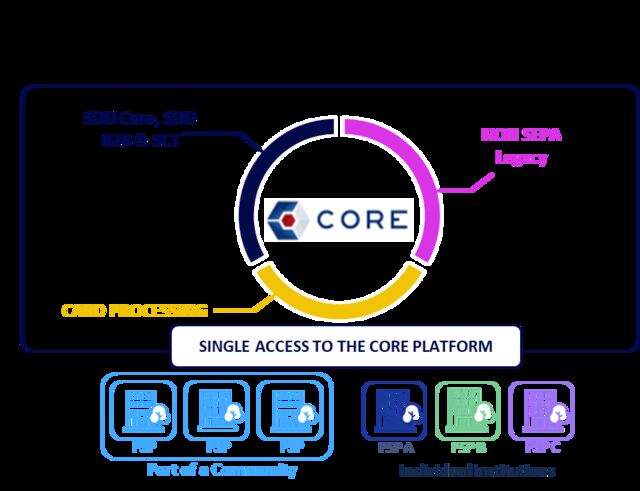
Clearing service, a European-Wide solution
The European payments market is diverse. The technical implementation of SEPA varies across national communities, and some legacy payment instruments still see significant usage.
The CORE platform offers a multi-rail, multi-tenant clearing and settlement service, and was the first service launched by STET in 2008.
Today, STET is one of the leading Automated Clearing Houses (ACH) in the Eurozone, processing over 17.7 billion transactions in 2024.
Providing Efficient Solutions to the Banking Industry
Regulations, competition, technology, and market demands are rapidly reshaping the payments landscape.
As Clearing & Settlement infrastructure, our role is to ensure the secure and efficient exchange of transactions between participants in our systems and to lead innovation by delivering tailored services that support the evolving business needs of our payments communities.
Our portfolio offers Payment Service Providers (PSPs) across SEPA an integrated Clearing & Settlement solution for all payment instruments. This includes bilateral and multilateral balance calculation, real-time position monitoring, exchange dashboards accessible via both GUI and A2A interfaces, optional guarantee funds, multilateral interbank fee calculation, comprehensive statistics, and much more.

Multi-CSM
The payments industry has made significant progress in harmonizing the 36.6 billion annual transactions into a single set of Scheme Rulebooks and messaging standards. However, differences persist at the national implementation level to accommodate market demands and practices.
The reality is that the new European payment landscape remains fragmented. This diversity must be seen as a strength and a source of innovation, rather than an obstacle.
Banking communities across Europe face critical decisions on how to consolidate their payments while maintaining governance and autonomy. SEPA, non-SEPA, card and non-euro payments all form pieces of this new and complex puzzle that must be assembled.

Supporting Different Clearing Models
Beyond the diversity of payment instruments in the European market, the most common source of variation in Clearing and Settlement arrangements is the Clearing Model itself.
There are two main Clearing Models:
Multilateral exchanges with multiple intraday cycles follow a Delivery-After-Settlement model, providing finality to delivered transactions. Multilateral exchanges with real-time clearing allow for continuous delivery of transactions, with finality ensured through a guarantee pool. Our CORE platform currently operates multiple CSMs on a shared technical architecture for access, processing and reporting. However, each CSM is configured separately to clear and settle according to the specific requirements of the community, whether continuous (France) or Multi-Cycle (Belgium).
We deliver efficiency through technical consolidation while supporting the unique clearing arrangements of each community.
Shared Technical Platform
Our Multi-CSM offering is designed to mitigate the impacts of system consolidation while delivering immediate benefits through economies of scale. Larger transaction volumes directly reduce the per-unit cost. A technical layer shared across all hosted CSMs ensures rapid adaptation to technological changes and reduces operational overhead.

Full Range of Payment Instruments Covered
Built from the ground up on XML technology, the CORE platform in a Multi-CSM configuration can host any of the following:
- SEPA schemes
- Non-SEPA and niche products
- Financial and non-financial products
- Cards
- AOS and regional services
Independent Governance per Community
Our approach emphasizes the need for self-governing communities, each with its own set of market practices.
The flexibility to support different models: Multicycle or continuous, with or without a Guarantee Fund.
Today, our communities, France and Belgium, exchange transactions in real time throughout the day, but the number of settlement cycles is defined independently by each community.
Depending on the choice of each community, settlement can either be carried out on a delivery-after-settlement basis, or continuously throughout the day with a guarantee mechanism.
For the French Community, transactions are processed in real time throughout the day, with a single daily settlement in TARGET2-RTGS. This settlement model is secured by a guarantee fund.
Provisions included in the security mechanism aim to ensure the integrity of transactions, thus securing all payment flows processed by the CORE (FR) system until settlement at the end of the day.
For the Belgian Community, STET operates 11 settlement cycles across 5 time windows per day, using a delivery-after-settlement model that helps to mitigate liquidity risk.
Access to the CORE platform is provided via a dedicated VPN or through SWIFTNET, depending on the community’s preference.
STET also provides a full suite of services such as IHM/GUI, Application-to-Application (A2A) and statistics.
This diversity is a clear example of the flexibility and adaptability of our Multi-CSM platform.
A European Playing Field
Built on a shared technical foundation and a Multi-CSM governance architecture, we provide processing, clearing, and settlement services to the CEC Community of Belgian banks via a dedicated CSM launched in February 2013.
The system delivers multi-cycle intraday Clearing services for the full range of payment instruments used in Belgium. Transactions are delivered only after settlement, eliminating counterparty risk for the entire banking community.
In 2024, the CORE (BE) platform handled over 1.5 billion transactions with a total value of 1,524 billion euros.